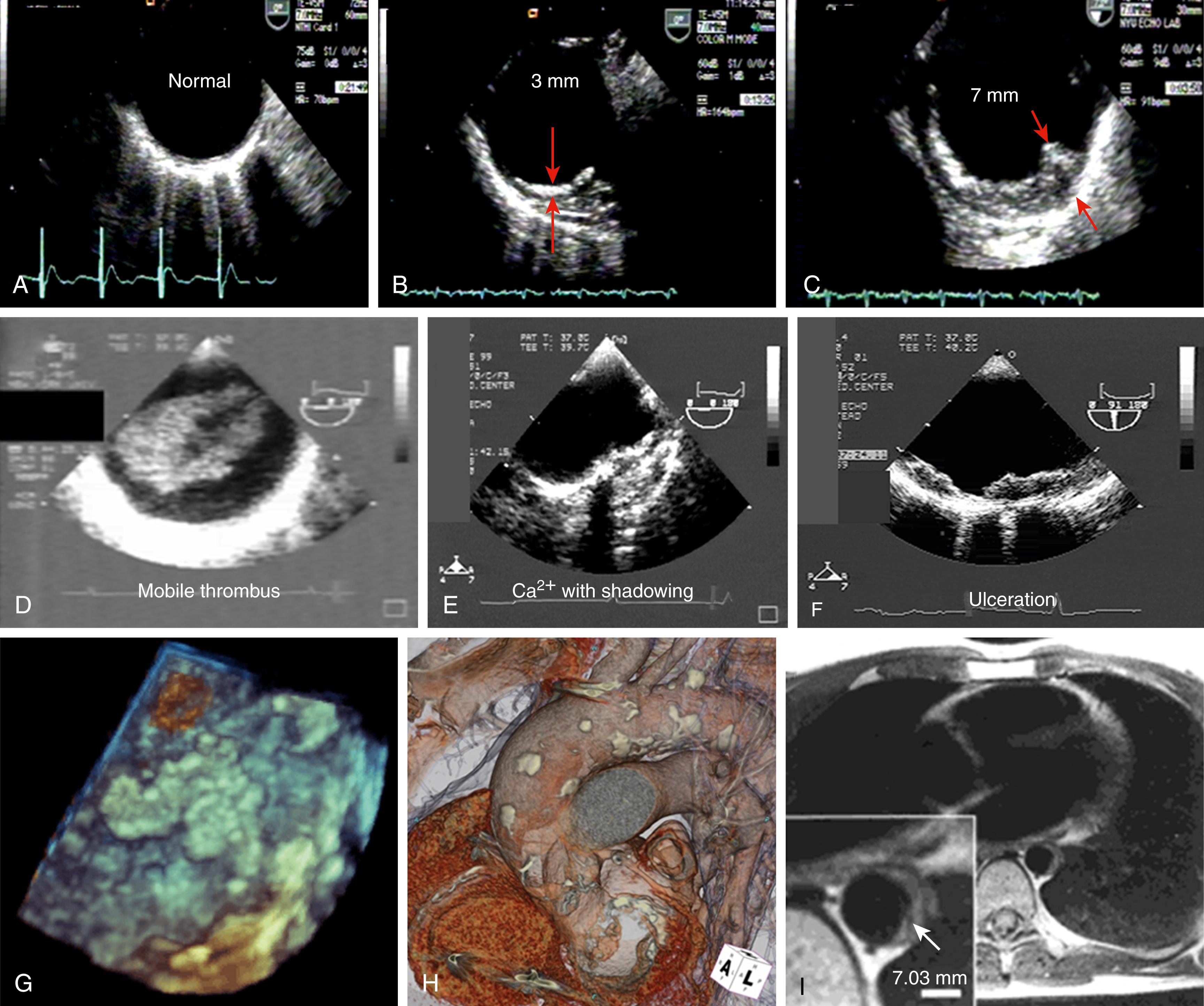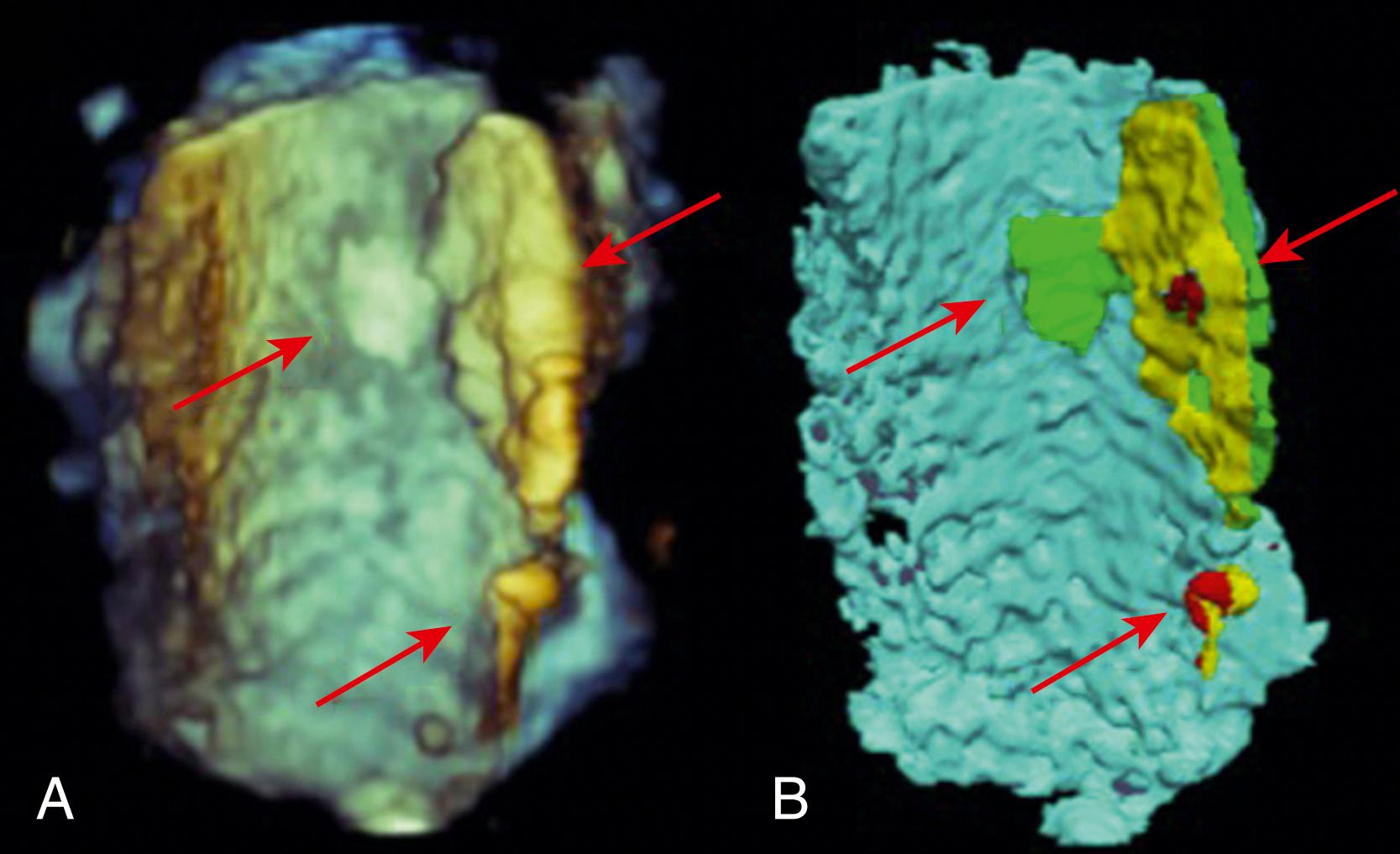Physical Address
304 North Cardinal St.
Dorchester Center, MA 02124
The authors would like to acknowledge the contribution of Dr. Paul A. Tunick, who was one of the authors for this chapter in the previous edition.
Nearly 150 years ago, P.L. Panum suggested that atherosclerotic material within the aorta can embolize to peripheral arteries. In a 1945 paper based on an autopsy, Flory showed that arterial occlusion was the result of aortic atherosclerotic plaque. However, modern imaging technologies, which include contrast angiography, computed tomography (CT), magnetic resonance imaging (MRI), transthoracic echocardiography (TTE), and transesophageal echocardiography (TEE), are required to evaluate aortic atherosclerosis in vivo. At present, two- and three-dimensional (3D) TEE provides accurate, high-resolution images of the thoracic aortic wall. This technique has also established the correlation among severe aortic plaque, stroke, and peripheral aortogenic embolism. Box 130.1 shows various names used in the medical literature to define this aortic pathology. For the sake of simplicity, we will use the term aortic plaque .
Aortic plaque
Complex aortic plaque
Eroded atheromatous plaque
Arteriosclerotic plaque
Aortic atheroma
Atheromatous aorta
Protruding atheroma
Aortic atherosclerosis
Atherosclerotic atheromatosis
Atherosclerotic debris
Almost the entire thoracic aorta can be visualized during a transesophageal examination. Multiplane views permit the visualization of each aortic segment except for a short segment at the junction of the aortic arch and the ascending aorta, which is masked by the air column inside the trachea. Normally, the aortic intima is smooth and thin ( Fig. 130.1A ). There is no evidence of irregularity, protrusion, calcification, or ulceration. Aortic plaque is considered mild when intimal thickness is 3 mm or less ( Fig. 130.1B ). Severe plaque is determined by intimal thickness of equal or more than 4 mm ( Fig. 130.1C ). If the plaque is unstable, there may be rupture and thrombus formation, which may be seen as a mobile mass ( Fig. 130.1D and ![]() , , ). Plaques can also show calcification ( Fig. 130.1E ) or ulcerations ( Fig. 130.1F ). 3D echocardiography may provide a more detailed and accurate topographic representation of aortic plaque, including exact location, shape, and thickness ( Fig. 130.1G and
, , ). Plaques can also show calcification ( Fig. 130.1E ) or ulcerations ( Fig. 130.1F ). 3D echocardiography may provide a more detailed and accurate topographic representation of aortic plaque, including exact location, shape, and thickness ( Fig. 130.1G and ![]() ) but can be a time-consuming process. Semiautomated plaque analysis systems are being studied for their role in plaque detection using 3D echocardiography and quantification of plaque size, thickness, and volume ( Fig. 130.2 ). This technology may provide a useful and more efficient way to determine disease severity and plaque burden in the future.
) but can be a time-consuming process. Semiautomated plaque analysis systems are being studied for their role in plaque detection using 3D echocardiography and quantification of plaque size, thickness, and volume ( Fig. 130.2 ). This technology may provide a useful and more efficient way to determine disease severity and plaque burden in the future.


Video 130.1. If the aortic plaque is unstable, there may be rupture and thrombus formation.
Video 130.2. If the aortic plaque is unstable, there may be rupture and thrombus formation.
Video 130.3. If the aortic plaque is unstable, there may be rupture and thrombus formation.
Video 130.4. Three-dimensional echocardiography may provide detailed topographic images of aortic plaque, including the exact location, shape, and thickness.
Plaques with thickness of 4 mm or more and those that contain ulceration or thrombus are defined as complex plaques . Many investigators have shown that complex plaques are associated with stroke and embolic events. Noncomplex plaques (i.e., <4 mm with no evidence of ulceration or clot) are significantly less dangerous. The amount of aortic plaque (also known as atherosclerotic burden) increases from the ascending aorta distally. It is also obvious that aortic plaques are only one manifestation of atherosclerosis and therefore are associated with a higher prevalence of coronary artery disease, carotid artery disease, renal artery stenosis, abdominal aortic aneurysms, and all the atherosclerotic risk factors.
Become a Clinical Tree membership for Full access and enjoy Unlimited articles
If you are a member. Log in here